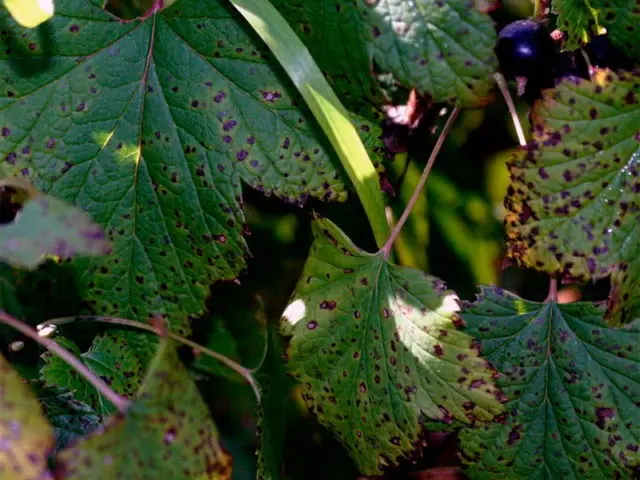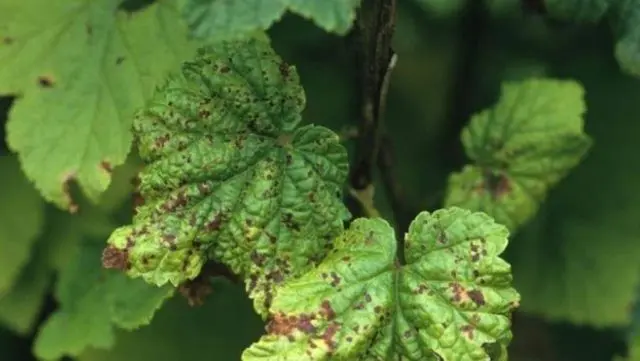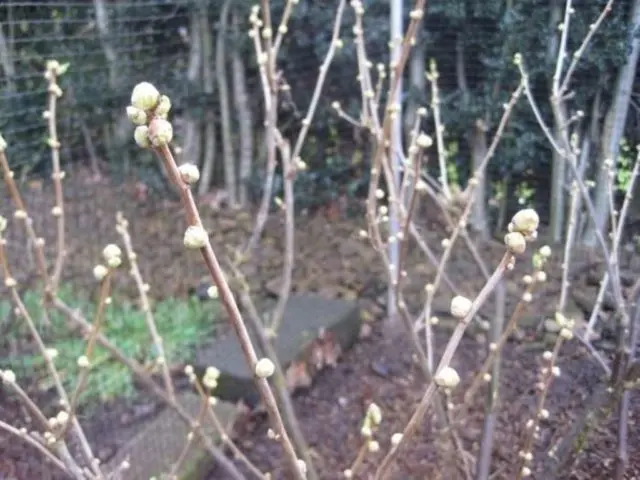Contents
Blackcurrant is a healthy and tasty berry, so it is often grown in household plots. Every gardener dreams of growing a healthy bush with large healthy berries. For this, gardeners select unpretentious, high-yielding varieties. The most popular currant is Autumn Waltz. The variety is cold-resistant and can grow and develop in regions with an unstable climate and cold winters.
Description of the currant variety Orlovsky Waltz
The blackcurrant variety Autumn Waltz was grown by crossing Lazy and Ershistaya varieties. The variety was entered into the State Register in 2008 and was approved for cultivation in the Volga-Vyatka region and in the west of Siberia.
The variety forms a vigorous, sprawling bush. Densely leafy shoots are thick, pubescent, painted in olive color. Old branches are gray, slightly shiny, thinned towards the top. The five-lobed leaves are rough, slightly wrinkled, painted in a pale green color. The central lobe is wide, with a sharp elongated apex. The lateral lobes are small, wide, with a pointed tip. The basal lobes are weakly expressed. The leaf plate is framed by small pointed teeth. The leaf is attached to the shoot with a short, slightly pubescent cutting.
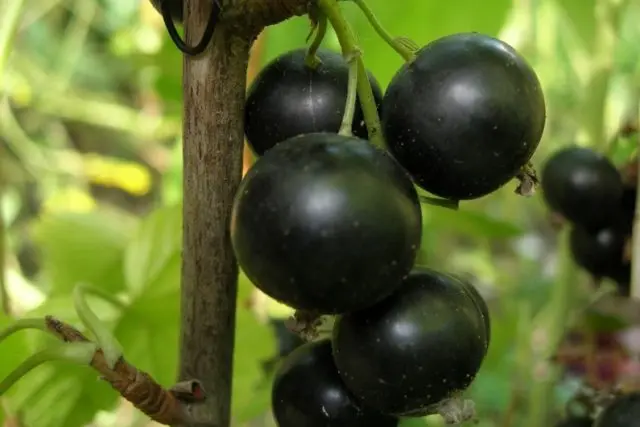
At the end of May, the bush is covered with light pink, small flowers collected in a short brush. After flowering, berries begin to form. Ripe, low-seeded fruits are painted black and have a dense, thick skin. The berry is large, weighing up to 3 g. Juicy pulp has a delicate aroma and sweet and sour taste. Blackcurrant fruits of the Autumn Waltz variety are very useful, 100 g of the product contains:
- dry matter – 12%;
- sugar – 7,6%;
- titratable acid – 3%.
- vitamin C – 133 mg;
- anthocyanins – 160 mg;
- catechins – 320 mg.
Thanks to the positive description, many gardeners have fallen in love with the blackcurrant Autumn Waltz. The variety can be grown both in the southern regions and in areas with an unstable, cold climate and short summers.
Features
Variety Autumn Waltz is popular with gardeners. But before purchasing a blackcurrant seedling Autumn Waltz, you need to study the description and characteristics of the variety, view photos and videos.
Drought resistance, frost resistance
Blackcurrant Autumn Waltz is a frost-resistant and drought-resistant variety. Thanks to these indicators, berry crops can be grown both in the south and in the northern regions. Blackcurrant does not need shelter for the winter, as it calmly tolerates a drop in temperature to -35 ° C. Only young specimens are covered for the winter. To do this, the soil is covered with a 15 cm layer of straw, rotted humus or compost.
Productivity of the variety
The variety is consistently high-yielding. Following the agrotechnical rules, up to 2 kg of fruits can be removed from the bush. Harvesting is carried out manually or mechanized. Due to the dense and thick peel, the berries do not wrinkle during harvesting, they tolerate long-term transportation well and have a high shelf life.
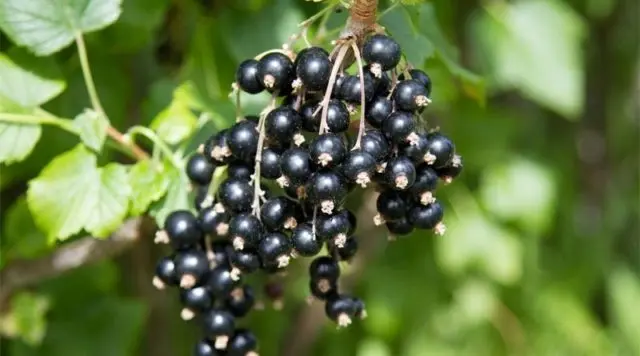
The blackcurrant variety Autumn Waltz ripens gradually, the harvest begins to be harvested from mid-July to early September.
Application area
Blackcurrant Autumn Waltz is a universal variety. Due to the high content of nutrients, the berries are consumed fresh, they are used to prepare jam, compotes and assorted berries.
Due to the elastic peel, the crop tolerates long-distance transportation well and has a long shelf life. Fresh, when stored in a cool room, the berry can lie for about 7-10 days.
Pros and cons of the variety
The blackcurrant variety Autumn Waltz has its strengths and weaknesses. The advantages include:
- high productivity;
- large-fruited;
- frost and drought resistance;
- good taste;
- long-term transportation;
- resistance to terry;
- versatility in application.
Many gardeners highlight the disadvantages of the variety:
- non-one-dimensionality;
- non-simultaneous ripening of berries;
- weak immunity to columnar rust and bud mites.
Methods of reproduction
When growing blackcurrant, you can quickly propagate your favorite varieties. There are 3 proven methods of reproduction:
- green cuttings;
- bends;
- woody cuttings.
Green cuttings
An easy way to breed blackcurrant. Seedlings are cut at the beginning of summer, 10 cm long. Planting material must contain at least 3 buds, the lower cut is made at an acute angle. The lower leaves are removed from the cutting, the upper ones are cut to half the length.
Prepared seedlings are set at an angle in light, nutritious soil, deepening it to the top foliage. After planting, the soil is mulched and watered abundantly.
After 14 days, the rooting process will begin, and after 3 months the cutting will turn into a strong, small bush up to 30 cm high. In early September, it can be moved to a prepared site. In order for the plant to safely endure the winter frosts, the trunk circle is mulched.
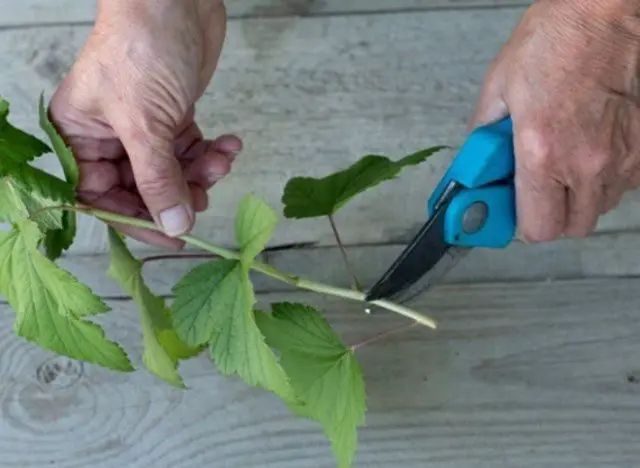
Odrevesnevshimi cuttings
The material is harvested in early spring, when the buds begin to wake up on the currant. Shoots are cut near the ground so that there are no stumps left on the plant. Further, cuttings 15-20 cm long are harvested from the mature part. Before planting, they are stored in snow, in bunches. From above, planting material is covered with straw or sawdust. Also, cuttings can be stored in the refrigerator until planting.
When the soil warms up to a depth of 15 cm, the cuttings can be planted in the chosen place. Each cutting is stuck at an angle into a light, nutritious soil with an interval of 30 cm from each other. The cuttings are buried so that 2-3 buds remain on the surface of the earth. Seedling care consists in regular watering and mulching of the soil. By the end of summer, the planting material will build up a strong root system and will be ready for transplanting to a permanent place.
Branches
In this way, annual, healthy shoots are rooted. Reproduction by branches is carried out in the spring, at the time of bud break. Before breeding, the soil is carefully loosened, fed with mineral and organic fertilizers, a trench is made 10 cm deep and a prepared shoot is laid in it, leaving the crown of the earth not on the surface. The trench is covered with soil, abundantly shed and mulched. After the buds wake up, young shoots will begin to grow from them. For the appearance of new lateral roots, it is necessary to carry out hilling with moist soil.
In autumn, rooted shoots are separated from the branch. Thus, a young seedling appears from each buried bud. The strongest is the one who is closest to the mother bush.
Planting and care
You need to purchase a blackcurrant seedling of the Autumn Waltz variety only in nurseries or from trusted suppliers. When buying, pay attention to the appearance of the plant. The roots must be well developed. Shoots without signs of rot, diseases and mechanical damage. For quick fruiting, a young plant is acquired at 2-3 years of age.
Acquired seedlings are planted in a well-lit place, as in the shade the berry loses its sugar content and acquires a sour taste. The soil for planting should be slightly acidic, light, fertile and well-drained. Blackcurrants should be planted near buildings or fences to protect the plant from cold, gusty winds.
A blackcurrant seedling is deepened by 5-10 cm. After planting, the branches are shortened by half or 2/3 of the length to cause rapid growth of young shoots. The interval between landings is 1-1,5 m.
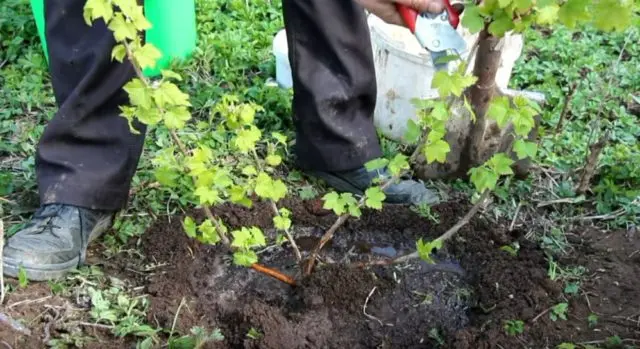
Aftercare
Blackcurrant Autumn Waltz is an unpretentious variety. But to get a generous harvest of tasty and healthy berries, you must adhere to simple agrotechnical rules:
- Despite the drought resistance, watering is carried out 2-3 times in 7 days at the rate of 10 liters per 1 bush. It is very important to carry out regular irrigation during the fruiting period and when laying flower buds.
- Top dressing of the bush is carried out in the spring at the beginning of the growing season. For this, a mineral complex of fertilizers and organics are used.
- After irrigation, the soil is loosened and mulched.
- For quick tillering, the first pruning is carried out after planting.
- Anti-aging pruning is carried out before bud break. To do this, shoots older than 5 years are cut at the root.
- Formative pruning is carried out in spring and autumn. Remove weak, diseased shoots, as well as deep-growing crowns.
- Thinning is carried out to increase productivity and prevent the appearance of diseases and pests.
Pests and diseases
The blackcurrant variety Orlovsky Waltz is resistant to many diseases and pests, but with improper care, currants can join:
- septoriosis – a fungal disease that appears in a humid climate, with insufficient lighting and with a dense planting. When the disease occurs, small brown spots appear on the leaf plate, which grow and discolor by mid-summer. At the first signs of the disease, damaged leaves and shoots are removed, and then the bush is treated with 1% Bordeaux liquid. For prevention, annual pruning of the bush, digging of row spacing and timely removal of plant residues are carried out.

- Antraknoz – the leaf plate is covered with small, red spots, which, without treatment, begin to grow, darken and swell. For prevention, a double treatment with 1% Bordeaux liquid is carried out: before the start of sap flow and in the fall after harvesting.

- Сcolumnar rust – the leaf plate is covered with small spots of orange color. Without treatment, the foliage curls, dries up and falls off. The bush is treated with fungicides or Bordeaux liquid 3 times per season: before the foliage blooms, during the formation of buds and after flowering.

- Мtartness – a viral disease that cannot be cured. When infected with a virus, the leaf blade lengthens and becomes pointed, and the flowers appear deformed and barren. When the first signs appear, diseased bushes are removed from the ground and burned.

- currant aphid – the first signs of the appearance of a pest are considered to be leaf curling and the formation of swollen neoplasms on the surface. To prevent the disease, currant bushes are shed in early spring by sprinkling with boiling water. When a pest is found, the plant is treated with broad-spectrum insecticides or folk remedies.

- The Mite – if large buds form on a bush in the spring, it means that the plant was struck by a bud mite. The tick is dangerous because it is a carrier of terry. In early May, infected buds are removed, and the bush is sprayed with broad-spectrum insecticides.

Conclusion
Currant Orlovsky Waltz is a high-yielding, frost-resistant variety that can be grown in the southern and northern regions. The plant is unpretentious, subject to agrotechnical rules and timely pruning, you can get a generous harvest of tasty and healthy berries.










